TOYOTA LAND CRUISER 2012 Owners Manual
Manufacturer: TOYOTA, Model Year: 2012, Model line: LAND CRUISER, Model: TOYOTA LAND CRUISER 2012Pages: 692, PDF Size: 29.3 MB
Page 311 of 692
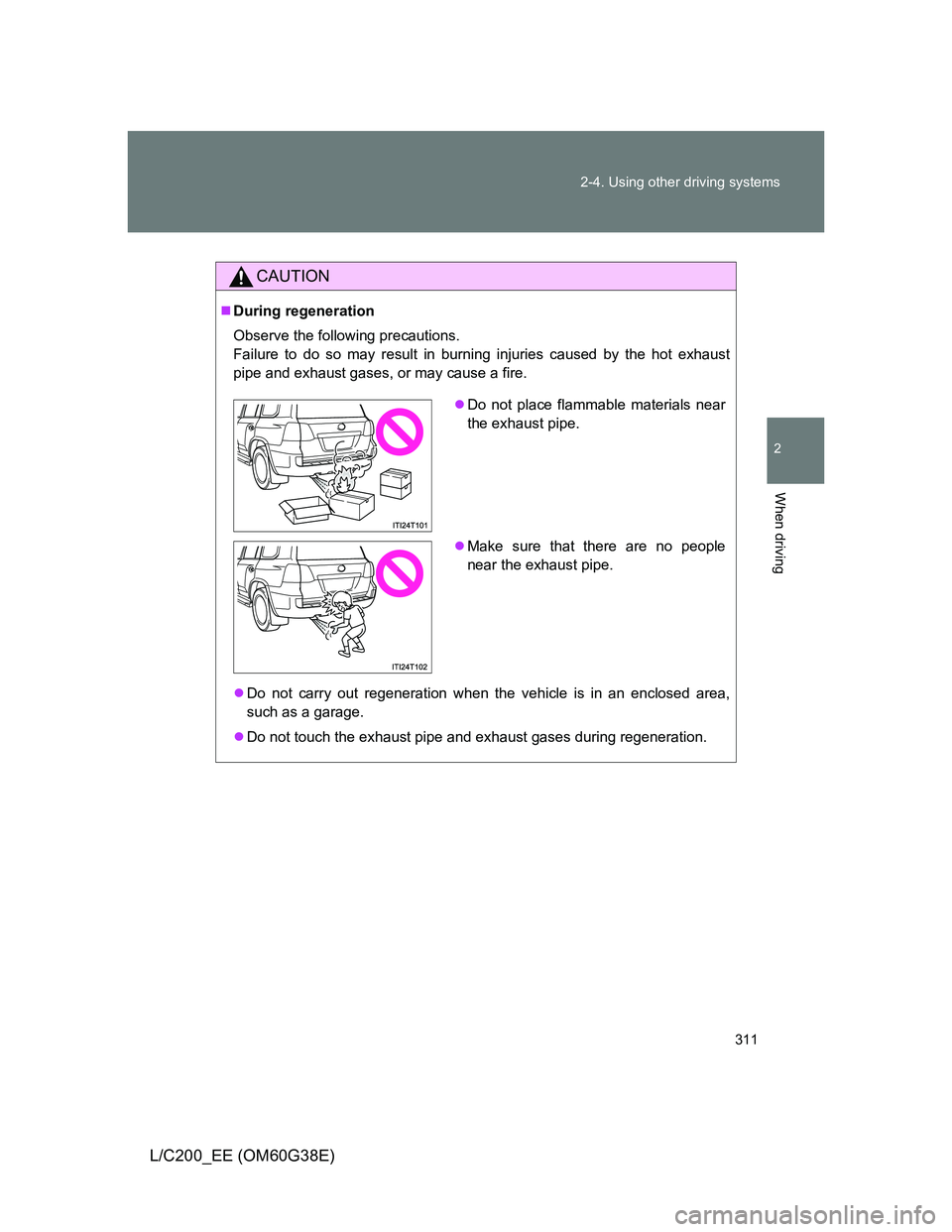
311 2-4. Using other driving systems
2
When driving
L/C200_EE (OM60G38E)
CAUTION
During regeneration
Observe the following precautions.
Failure to do so may result in burning injuries caused by the hot exhaust
pipe and exhaust gases, or may cause a fire.
Do not carry out regeneration when the vehicle is in an enclosed area,
such as a garage.
Do not touch the exhaust pipe and exhaust gases during regeneration.
Do not place flammable materials near
the exhaust pipe.
Make sure that there are no people
near the exhaust pipe.
Page 312 of 692
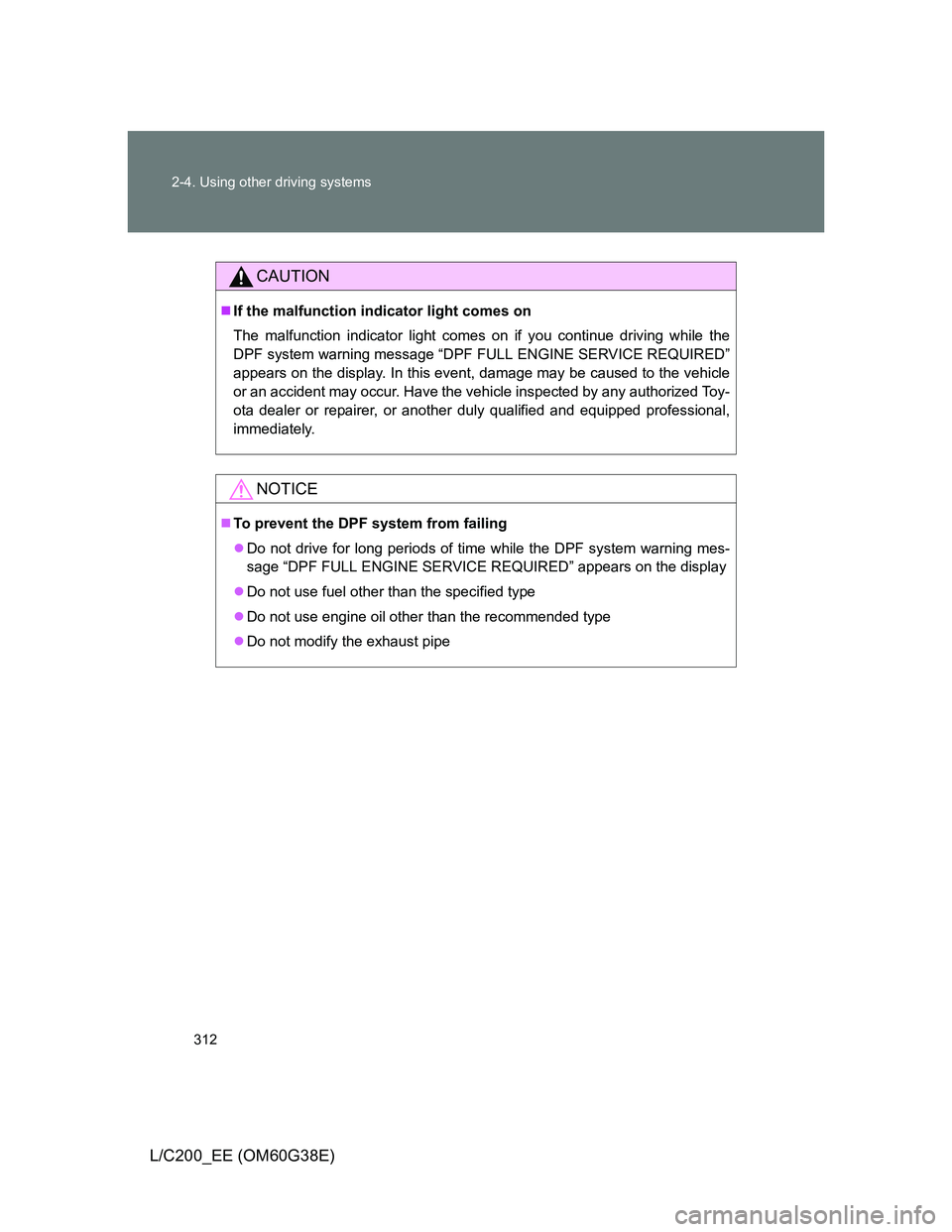
312 2-4. Using other driving systems
L/C200_EE (OM60G38E)
CAUTION
If the malfunction indicator light comes on
The malfunction indicator light comes on if you continue driving while the
DPF system warning message “DPF FULL ENGINE SERVICE REQUIRED”
appears on the display. In this event, damage may be caused to the vehicle
or an accident may occur. Have the vehicle inspected by any authorized Toy-
ota dealer or repairer, or another duly qualified and equipped professional,
immediately.
NOTICE
To prevent the DPF system from failing
Do not drive for long periods of time while the DPF system warning mes-
sage “DPF FULL ENGINE SERVICE REQUIRED” appears on the display
Do not use fuel other than the specified type
Do not use engine oil other than the recommended type
Do not modify the exhaust pipe
Page 313 of 692
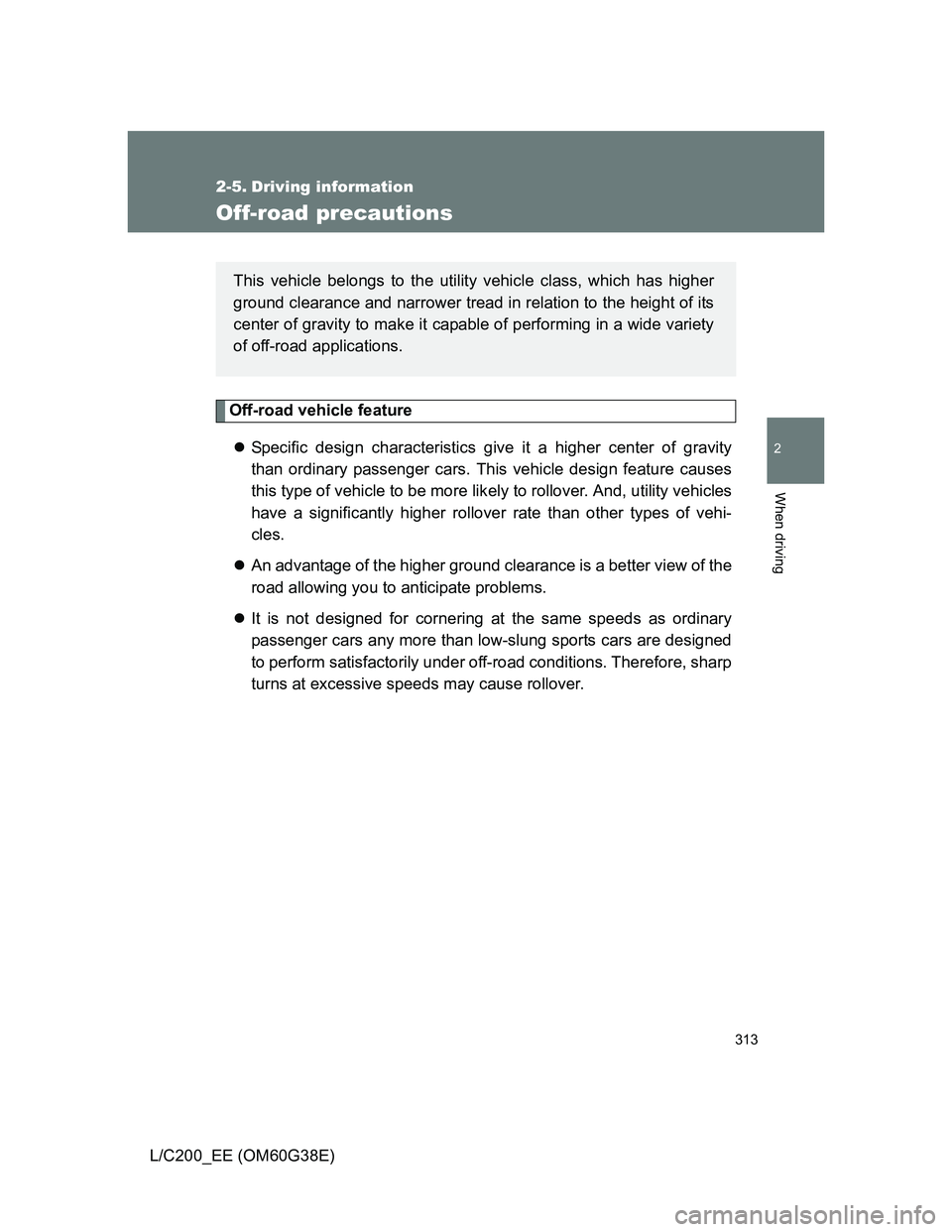
313
2
When driving
L/C200_EE (OM60G38E)
2-5. Driving information
Off-road precautions
Off-road vehicle feature
Specific design characteristics give it a higher center of gravity
than ordinary passenger cars. This vehicle design feature causes
this type of vehicle to be more likely to rollover. And, utility vehicles
have a significantly higher rollover rate than other types of vehi-
cles.
An advantage of the higher ground clearance is a better view of the
road allowing you to anticipate problems.
It is not designed for cornering at the same speeds as ordinary
passenger cars any more than low-slung sports cars are designed
to perform satisfactorily under off-road conditions. Therefore, sharp
turns at excessive speeds may cause rollover.
This vehicle belongs to the utility vehicle class, which has higher
ground clearance and narrower tread in relation to the height of its
center of gravity to make it capable of performing in a wide variety
of off-road applications.
Page 314 of 692
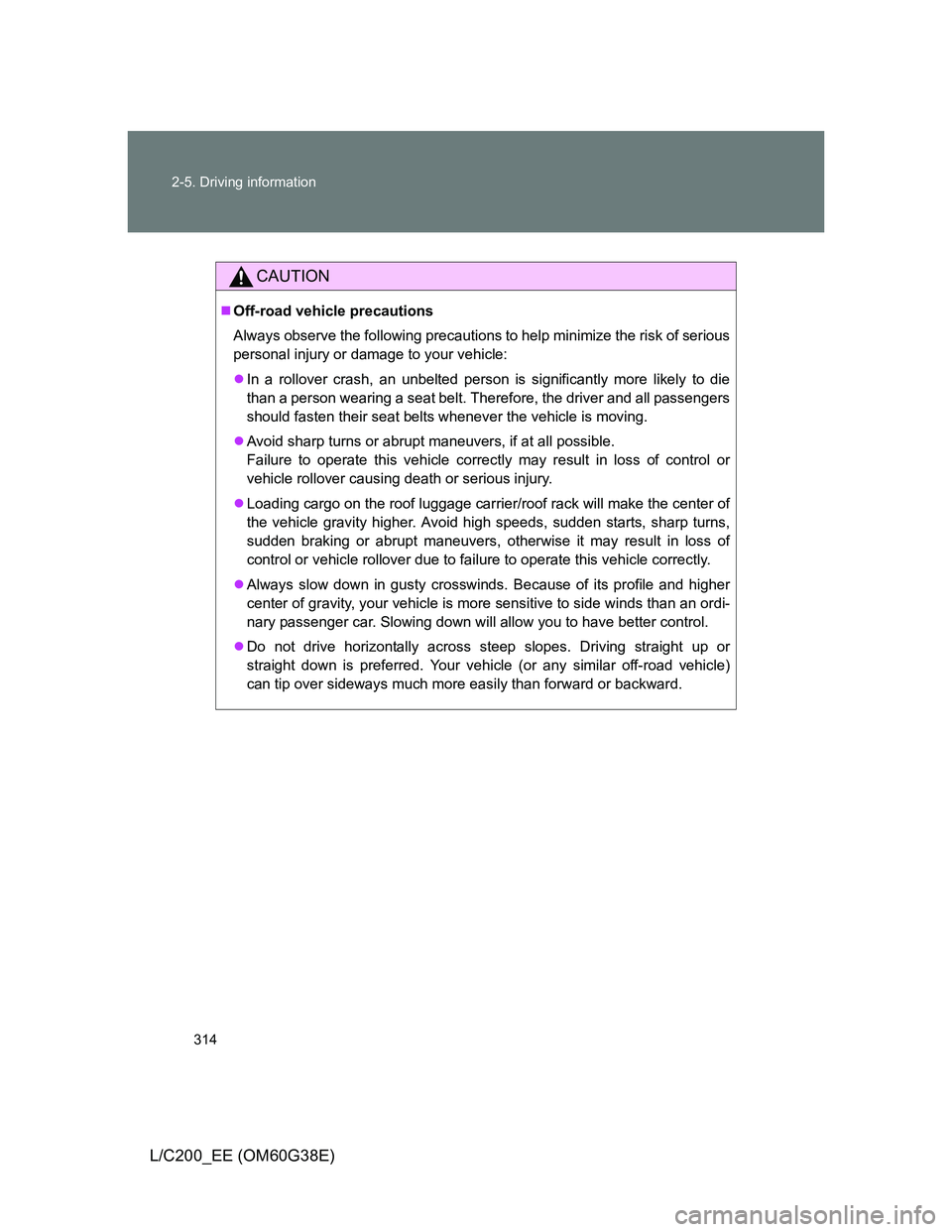
314 2-5. Driving information
L/C200_EE (OM60G38E)
CAUTION
Off-road vehicle precautions
Always observe the following precautions to help minimize the risk of serious
personal injury or damage to your vehicle:
In a rollover crash, an unbelted person is significantly more likely to die
than a person wearing a seat belt. Therefore, the driver and all passengers
should fasten their seat belts whenever the vehicle is moving.
Avoid sharp turns or abrupt maneuvers, if at all possible.
Failure to operate this vehicle correctly may result in loss of control or
vehicle rollover causing death or serious injury.
Loading cargo on the roof luggage carrier/roof rack will make the center of
the vehicle gravity higher. Avoid high speeds, sudden starts, sharp turns,
sudden braking or abrupt maneuvers, otherwise it may result in loss of
control or vehicle rollover due to failure to operate this vehicle correctly.
Always slow down in gusty crosswinds. Because of its profile and higher
center of gravity, your vehicle is more sensitive to side winds than an ordi-
nary passenger car. Slowing down will allow you to have better control.
Do not drive horizontally across steep slopes. Driving straight up or
straight down is preferred. Your vehicle (or any similar off-road vehicle)
can tip over sideways much more easily than forward or backward.
Page 315 of 692
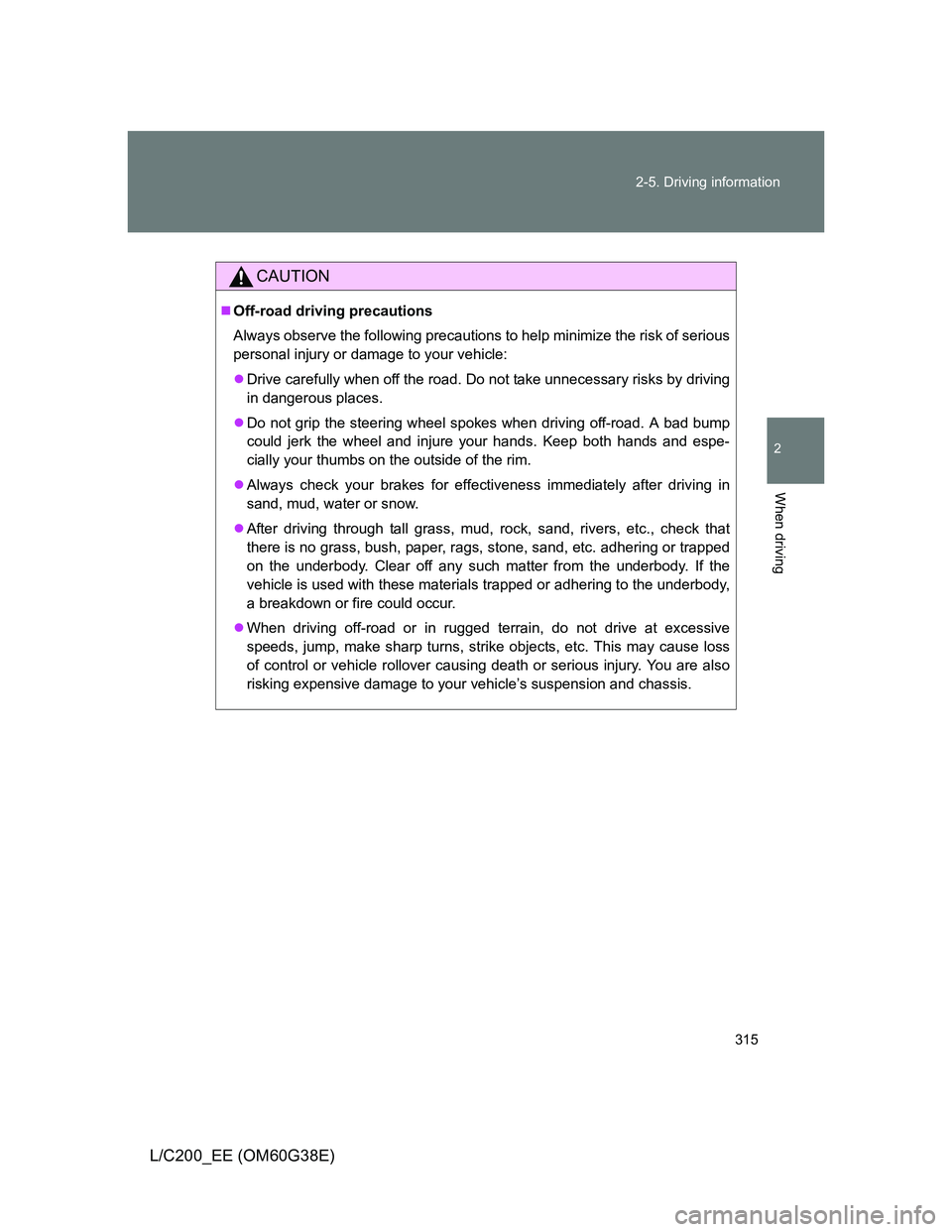
315 2-5. Driving information
2
When driving
L/C200_EE (OM60G38E)
CAUTION
Off-road driving precautions
Always observe the following precautions to help minimize the risk of serious
personal injury or damage to your vehicle:
Drive carefully when off the road. Do not take unnecessary risks by driving
in dangerous places.
Do not grip the steering wheel spokes when driving off-road. A bad bump
could jerk the wheel and injure your hands. Keep both hands and espe-
cially your thumbs on the outside of the rim.
Always check your brakes for effectiveness immediately after driving in
sand, mud, water or snow.
After driving through tall grass, mud, rock, sand, rivers, etc., check that
there is no grass, bush, paper, rags, stone, sand, etc. adhering or trapped
on the underbody. Clear off any such matter from the underbody. If the
vehicle is used with these materials trapped or adhering to the underbody,
a breakdown or fire could occur.
When driving off-road or in rugged terrain, do not drive at excessive
speeds, jump, make sharp turns, strike objects, etc. This may cause loss
of control or vehicle rollover causing death or serious injury. You are also
risking expensive damage to your vehicle’s suspension and chassis.
Page 316 of 692
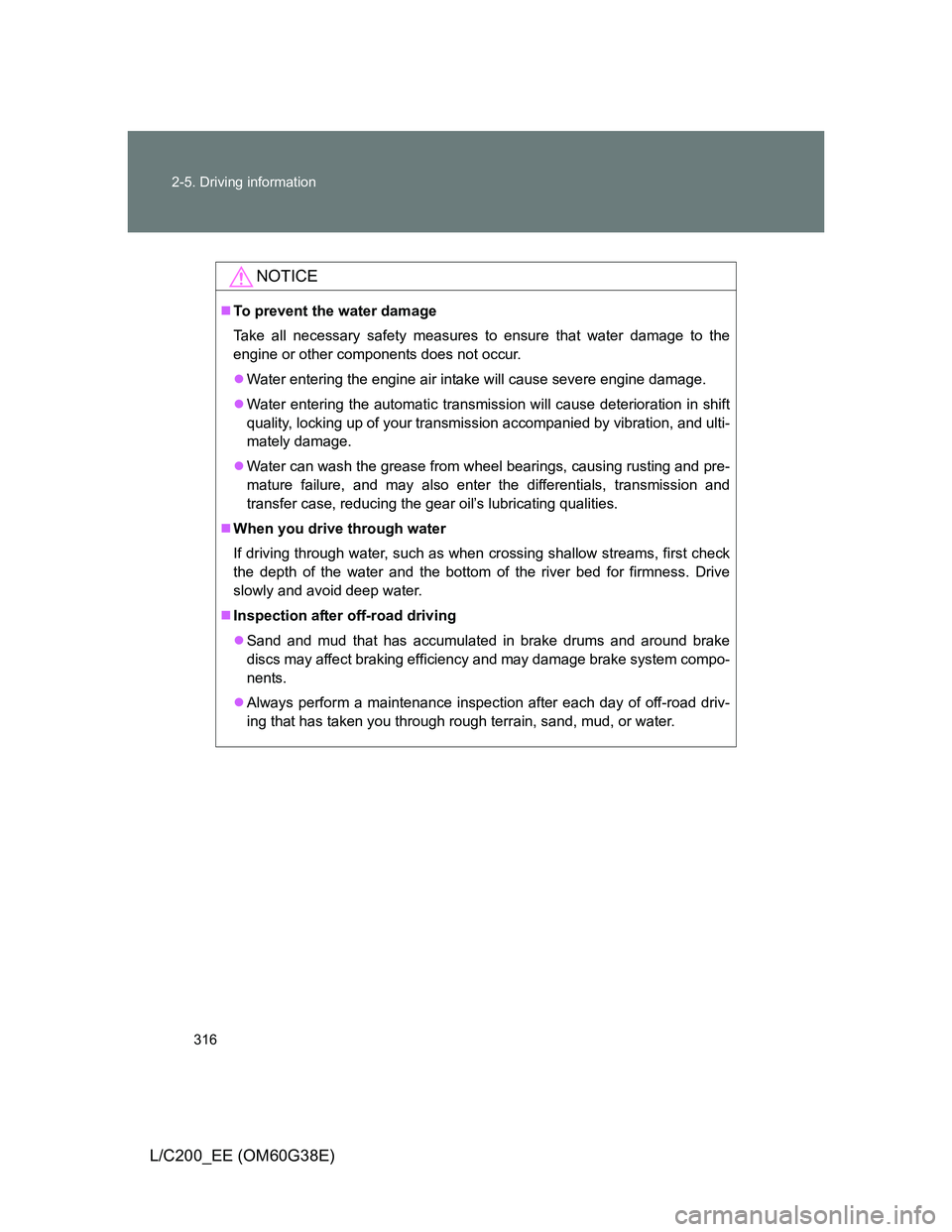
316 2-5. Driving information
L/C200_EE (OM60G38E)
NOTICE
To prevent the water damage
Take all necessary safety measures to ensure that water damage to the
engine or other components does not occur.
Water entering the engine air intake will cause severe engine damage.
Water entering the automatic transmission will cause deterioration in shift
quality, locking up of your transmission accompanied by vibration, and ulti-
mately damage.
Water can wash the grease from wheel bearings, causing rusting and pre-
mature failure, and may also enter the differentials, transmission and
transfer case, reducing the gear oil’s lubricating qualities.
When you drive through water
If driving through water, such as when crossing shallow streams, first check
the depth of the water and the bottom of the river bed for firmness. Drive
slowly and avoid deep water.
Inspection after off-road driving
Sand and mud that has accumulated in brake drums and around brake
discs may affect braking efficiency and may damage brake system compo-
nents.
Always perform a maintenance inspection after each day of off-road driv-
ing that has taken you through rough terrain, sand, mud, or water.
Page 317 of 692
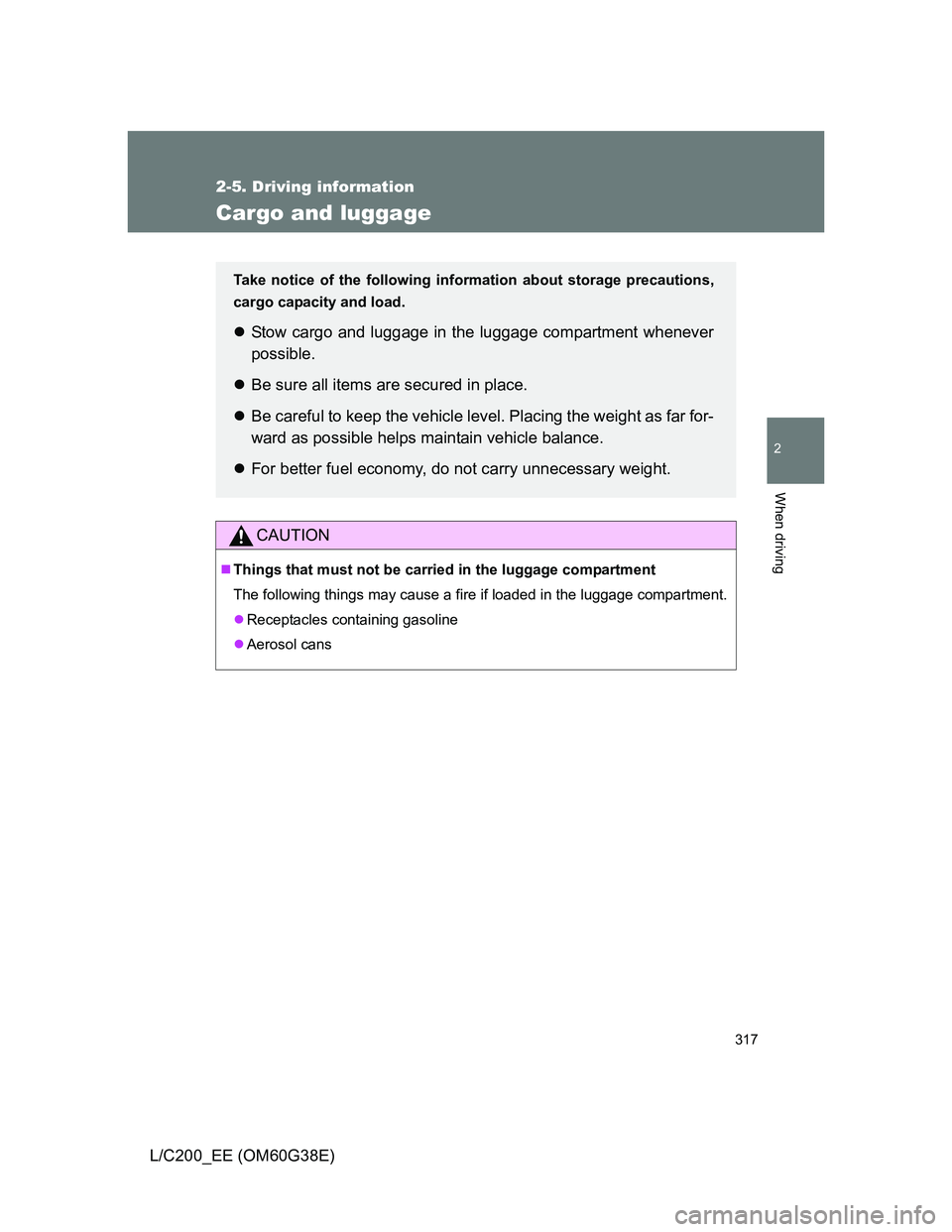
317
2-5. Driving information
2
When driving
L/C200_EE (OM60G38E)
Cargo and luggage
CAUTION
Things that must not be carried in the luggage compartment
The following things may cause a fire if loaded in the luggage compartment.
Receptacles containing gasoline
Aerosol cans
Take notice of the following information about storage precautions,
cargo capacity and load.
Stow cargo and luggage in the luggage compartment whenever
possible.
Be sure all items are secured in place.
Be careful to keep the vehicle level. Placing the weight as far for-
ward as possible helps maintain vehicle balance.
For better fuel economy, do not carry unnecessary weight.
Page 318 of 692
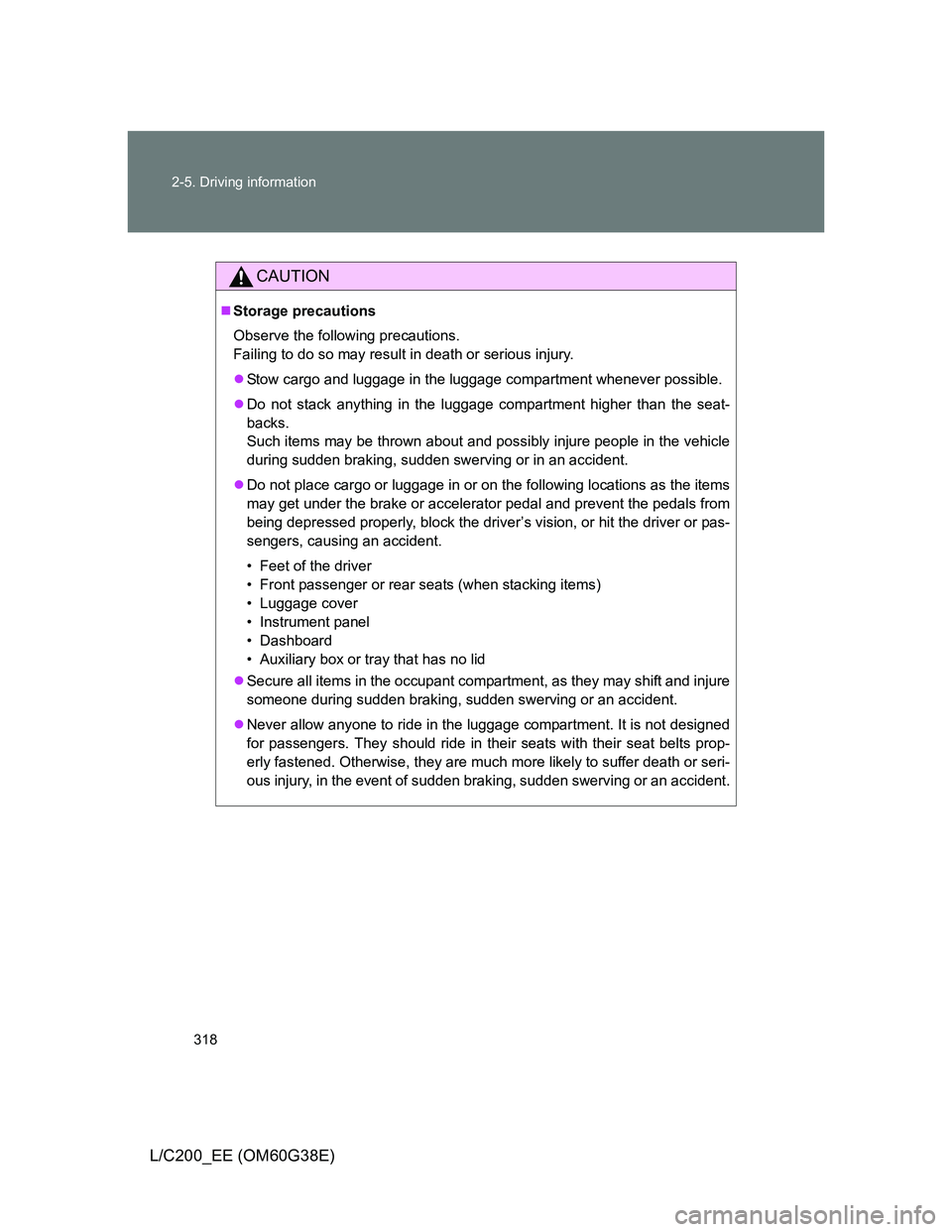
318 2-5. Driving information
L/C200_EE (OM60G38E)
CAUTION
Storage precautions
Observe the following precautions.
Failing to do so may result in death or serious injury.
Stow cargo and luggage in the luggage compartment whenever possible.
Do not stack anything in the luggage compartment higher than the seat-
backs.
Such items may be thrown about and possibly injure people in the vehicle
during sudden braking, sudden swerving or in an accident.
Do not place cargo or luggage in or on the following locations as the items
may get under the brake or accelerator pedal and prevent the pedals from
being depressed properly, block the driver’s vision, or hit the driver or pas-
sengers, causing an accident.
• Feet of the driver
• Front passenger or rear seats (when stacking items)
• Luggage cover
• Instrument panel
• Dashboard
• Auxiliary box or tray that has no lid
Secure all items in the occupant compartment, as they may shift and injure
someone during sudden braking, sudden swerving or an accident.
Never allow anyone to ride in the luggage compartment. It is not designed
for passengers. They should ride in their seats with their seat belts prop-
erly fastened. Otherwise, they are much more likely to suffer death or seri-
ous injury, in the event of sudden braking, sudden swerving or an accident.
Page 319 of 692
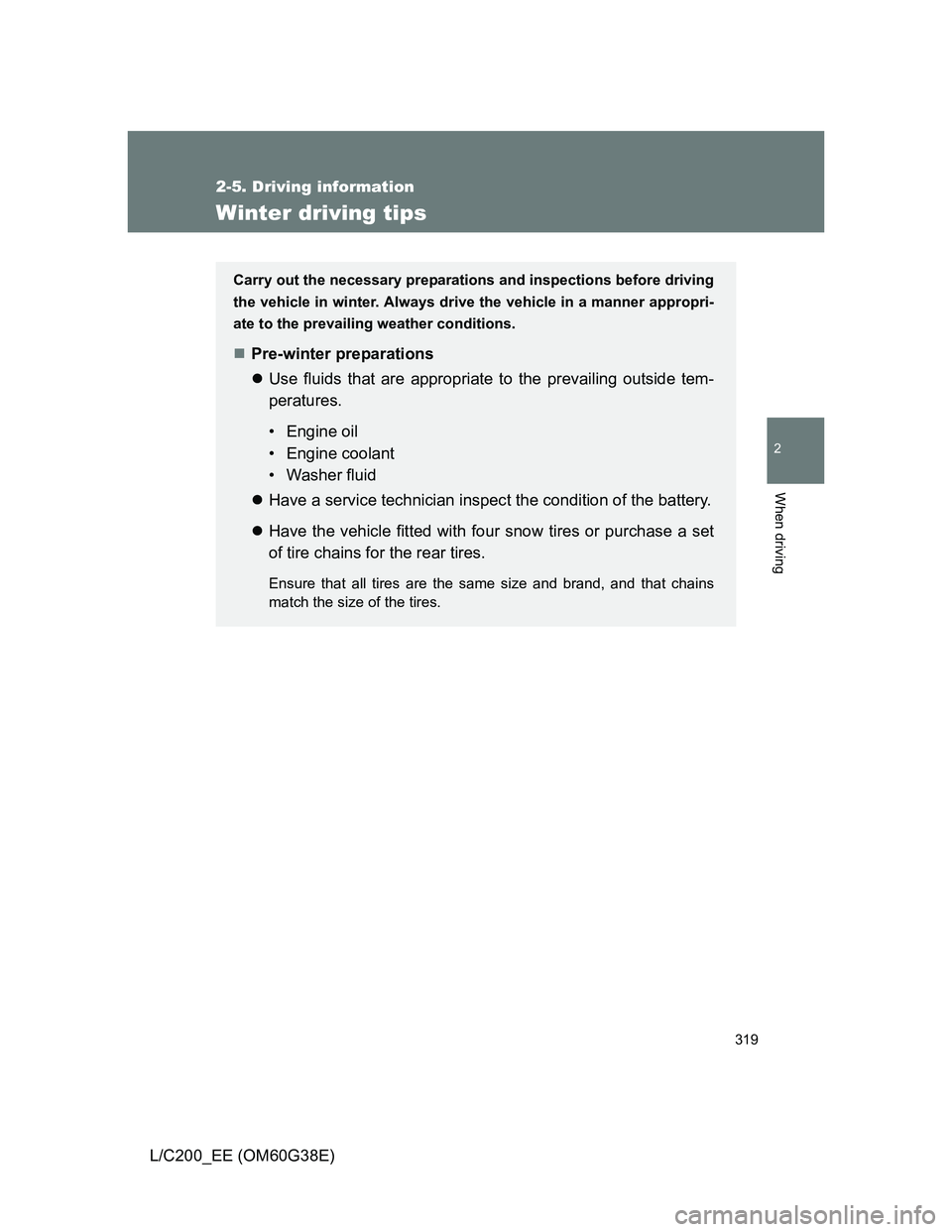
319
2-5. Driving information
2
When driving
L/C200_EE (OM60G38E)
Winter driving tips
Carry out the necessary preparations and inspections before driving
the vehicle in winter. Always drive the vehicle in a manner appropri-
ate to the prevailing weather conditions.
Pre-winter preparations
Use fluids that are appropriate to the prevailing outside tem-
peratures.
• Engine oil
• Engine coolant
• Washer fluid
Have a service technician inspect the condition of the battery.
Have the vehicle fitted with four snow tires or purchase a set
of tire chains for the rear tires.
Ensure that all tires are the same size and brand, and that chains
match the size of the tires.
Page 320 of 692
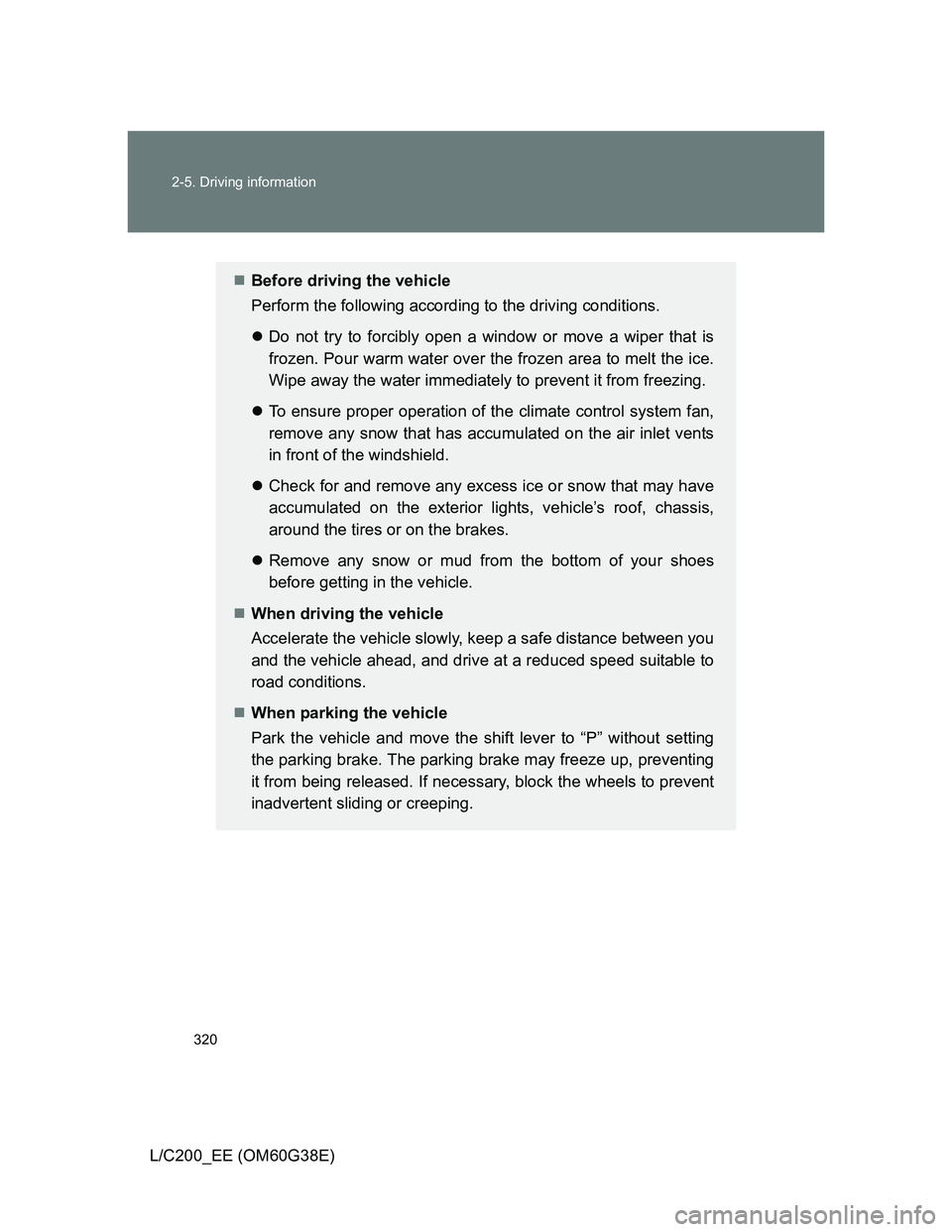
320 2-5. Driving information
L/C200_EE (OM60G38E)
Before driving the vehicle
Perform the following according to the driving conditions.
Do not try to forcibly open a window or move a wiper that is
frozen. Pour warm water over the frozen area to melt the ice.
Wipe away the water immediately to prevent it from freezing.
To ensure proper operation of the climate control system fan,
remove any snow that has accumulated on the air inlet vents
in front of the windshield.
Check for and remove any excess ice or snow that may have
accumulated on the exterior lights, vehicle’s roof, chassis,
around the tires or on the brakes.
Remove any snow or mud from the bottom of your shoes
before getting in the vehicle.
When driving the vehicle
Accelerate the vehicle slowly, keep a safe distance between you
and the vehicle ahead, and drive at a reduced speed suitable to
road conditions.
When parking the vehicle
Park the vehicle and move the shift lever to “P” without setting
the parking brake. The parking brake may freeze up, preventing
it from being released. If necessary, block the wheels to prevent
inadvertent sliding or creeping.